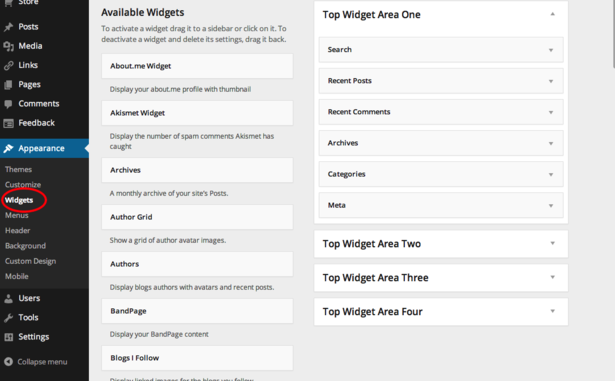
A blog can still take you to the top. If you do it right.
Everyone loves free information. And free information reels in customers. That’s why blogging is one of the best ways to do content marketing. How else are you going to bombard customers with a steady stream of content without scaring them away?
According to Neil Patel, “Companies with blogs typically receive 97% more leads than companies without blogs.” Customers might ignore your ad, but your blog? That’s something they want to read. Blogging creates a human side to your website or company or organization.
And blogging is most definitely a way to keep your face in front of current and potential customers.
Use WordPress
Matt Cutts, SEO guru and chief spam buster at Google, has said that WordPress is the best platform for optimized blogging. He uses it himself.
WordPress is easy. It’s free. And it handles search engine optimization like a pro.
It solves 80-90% of your SEO problems. And that’s saying a lot, because SEO is a many-faceted thing.
WordPress has a permalink setting that you can set to Post Name so that when you write a blog, it will be www.coolblog.com/dog-collar-fashion-trends instead of www.coolblog.com/?=123. Guess which one the Google robot is going to like the best?
It also has plugins for almost everything. Some SEO must-haves are a sitemap generator, a webmaster toolkit, and a meta/SEO tool.
A sitemap will make it easier for search engines to find all your pages and posts, which will help you move up in search results. The webmaster tools will help you spot problem areas with your site. And the meta/SEO tools will make it easy for you to keep your site optimized for more exposure to the masses.
What’s more, WordPress can make you look good with a few clicks. If you suck at web design, you can still have a fantastic-looking blog, thanks to WordPress’s almost endless lineup of premium themes.
Quality, quality, quality
Search engine bots are looking for sites with authority and trust.
They want to know that your site knows what it’s talking about and that the online neighborhood agrees. In case you’re wondering, the neighborhood is the collection of other sites, business, social media influencers, and the like that are in your field or area of interest. If they’re sharing your content, the search engines take notice.
What’s your bounce rate? Do visitors click and leave or are they staying long enough to read all of your amazing blogs? The length of engagement matters (and marriage is around the corner).
Use normal language. If your blog sounds like an elementary school child or someone with English as a second language wrote it, Google will know. And so will your site visitors.
Google bots will also know if your site has duplicate, repetitive, or mass-produced content. When it comes to content, quality is better than quantity.
Keep it fresh… and keep it coming
Google and Bing bots love fresh content.
They score the freshness factor of a web page from the date it was first discovered by the bots or the date it was last updated substantially enough to warrant notice.
Content needs to be fresh – not wilted, stale, outdated content that’s been on your site since 1999. To solve this dilemma, you can repurpose existing content. Or you can create new content via your blog. A new blog = a new page on your site. You’ll score some points with the search engines for that.
But don’t just churn out robotic content. Switch it up every so often. If your site is starting to sound predictable: why you should make papier-mâché… blah, blah… how often you should make papier-mâché… blah, blah… when you should make papier-mâché… you need a new angle, a new idea, a new topic – something!
A blog is an excellent platform for all manner of content – articles, infographics, podcasts, videos, news updates, how-to-guides, white papers, case studies, memes – anything that keeps you in front of the faces of current and potential customers.
Don’t ever let them forget you’re alive.
Linking – a fine line
Every good blogger knows that a site with multiple, quality links is going to gain kudos with the web crawlers.
However, due to link schemes (a practice where links are used to manipulate search engine rankings) links coming into your site (backlinks) are scrutinized by the search engine bots.
Where are your links coming from? Are they coming from trusted sites? Or are they coming from seedy neighbors, such as link farms?
You can build quality links by guest posting on sites with a high authority (or high trust) rating. Just make sure they’re in your your industry or niche. For instance, if your site is about bird watching, look for home and garden sites, wildlife blogs, and the like.
You can also build relationships with other webmasters by placing outbound links in your on-site blog posts. Here again, make sure every link is on-topic i.e., don’t link to a page on catnip if you’re writing about luxury cars, unless you’re actually writing about the relationship between luxury cars and catnip.
Blogging is about building quality relationships – both with your readership and with websites in your neighborhood.
Commit to the long haul
Blogging won’t necessarily get you to the top of Google and Bing overnight. It’s a long-term strategy to build trust, value, and momentum. There is no McBlogging shortcut.
While not every blog post may be sensational, every post does need to provide value to the reader. Ultimately, that’s what you’re after. Because more engagement and more shares lead to higher rankings, more visibility, and more customers.
What have you got to lose?
This post was originally published on our sister site Search Engine Watch, but we thought the ClickZ audience would find it useful.
Source: ClickZ
Link: Blogging for SEO: five beginners’ tips



Leave a Reply